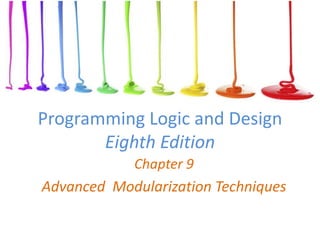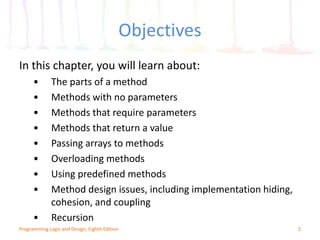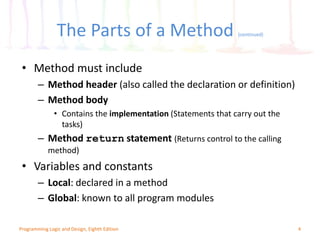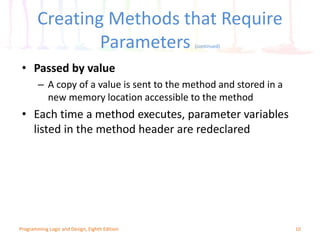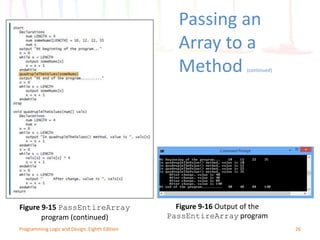Intro to Programming: Modularity
- 1. Programming Logic and Design Eighth Edition Chapter 9 Advanced Modularization Techniques
- 2. Objectives In this chapter, you will learn about: • The parts of a method • Methods with no parameters • Methods that require parameters • Methods that return a value • Passing arrays to methods • Overloading methods • Using predefined methods • Method design issues, including implementation hiding, cohesion, and coupling • Recursion 2Programming Logic and Design, Eighth Edition
- 3. The Parts of a Method 3Programming Logic and Design, Eighth Edition • Method – A program module that contains a series of statements that carry out a task – Invoke or call a method from another program or method – Any program can contain an unlimited number of methods – Each method can be called an unlimited number of times
- 4. The Parts of a Method (continued) 4Programming Logic and Design, Eighth Edition • Method must include – Method header (also called the declaration or definition) – Method body • Contains the implementation (Statements that carry out the tasks) – Method return statement (Returns control to the calling method) • Variables and constants – Local: declared in a method – Global: known to all program modules
- 5. 5Programming Logic and Design, Eighth Edition Figure 9-1 A program that calculates the user’s weight on the moon Using Methods with No Parameters Figure 9-2 Output of moon weight calculator program
- 6. Using Methods with No Parameters (continued) 6Programming Logic and Design, Eighth Edition • When methods must share data – Pass the data into and return the data out of methods • When you call a method from a program, you must know three things: – Name of the called method – Type of information to send to the method, if any – Type of return data to expect from the method, if any
- 7. Creating Methods that Require Parameters 7Programming Logic and Design, Eighth Edition • Argument to the method – Pass a data item into a method from a calling program • Parameter to the method – Method receives the data item • To write the declaration for a method that can receive a parameter, you must know: – The type of the parameter – The local name for the parameter
- 8. Creating Methods that Require Parameters (continued) 8Programming Logic and Design, Eighth Edition • Parameter list – Types and names of parameters • Signature – Method’s name and parameter list
- 9. Creating Methods that Require Parameters (continued) 9Programming Logic and Design, Eighth Edition • Improve the moon weight program by making the final output more user-friendly • Several approaches – Rewrite the program without including any methods – Retain the displayInstructions() method, but make the langCode variable global – Retain the displayInstructions() method as is, but add a section to the main program that also asks the user for a preferred language – Store the variable that holds the language code in the main program
- 10. Creating Methods that Require Parameters (continued) 10Programming Logic and Design, Eighth Edition • Passed by value – A copy of a value is sent to the method and stored in a new memory location accessible to the method • Each time a method executes, parameter variables listed in the method header are redeclared
- 11. Creating Methods that Require Multiple Parameters 11Programming Logic and Design, Eighth Edition • Methods can require more than one parameter – List the arguments within the method call, separated by commas – List a data type and local identifier for each parameter within the method header’s parentheses – Separate each declaration with a comma – The data type must be repeated with each parameter – Arguments sent are called actual parameters – Variables that accept the parameters in the method are called formal parameters
- 12. 12Programming Logic and Design, Eighth Edition Figure 9-7 A program that calls a computeTax() method that requires two parameters Creating Methods that Require Multiple Parameters (continued)
- 13. Creating Methods that Return a Value 13Programming Logic and Design, Eighth Edition • A variable declared within a method ceases to exist when the method ends – Goes out of scope • To retain a value that exists when a method ends, return the value from the method back to the calling method • When a method returns a value, the method must have a return type that matches the data type of the value that is returned
- 14. Creating Methods that Return a Value (continued) 14Programming Logic and Design, Eighth Edition • Return type for a method – Indicates the data type of the value that the method will send back – Can be any type – Also called method’s type – Listed in front of the method name when the method is defined • Method can also return nothing – Return type void – Void method
- 15. Creating Methods that Return a Value (continued) 15Programming Logic and Design, Eighth Edition • Example: num getHoursWorked() – Returns a numeric value • Usually, you want to use the returned value in the calling method – Not required – Store in variable or use directly without storing • output "Hours worked is ", getHoursWorked()
- 16. 16Programming Logic and Design, Eighth Edition Figure 9-8 A payroll program that calls a method that returns a value Figure 9-9 A program that uses a method’s returned value without storing it Creating Methods that Return a Value (continued)
- 17. 17Programming Logic and Design, Eighth Edition Creating Methods that Return a Value (continued) • Technically, you are allowed to include multiple return statements in a method – It’s not recommended – Violates structured logic
- 18. 18Programming Logic and Design, Eighth Edition Creating Methods that Return a Value (continued) Figure 9-10 Unstructured approach to returning one of several values
- 19. 19Programming Logic and Design, Eighth Edition Figure 9-11 Recommended, structured approach to returning one of several values Creating Methods that Return a Value (continued)
- 20. 20Programming Logic and Design, Eighth Edition Creating Methods that Return a Value (continued) • To use a method, you should know: – What the method does in general, but not necessarily how it carries out tasks internally – The method’s name – The method’s required parameters, if any – The method’s return type, so that you can use any returned value appropriately
- 21. 21Programming Logic and Design, Eighth Edition • IPO chart – A tool that identifies and categorizes each item in a method by input, processing, and output • A method that finds the smallest of three numeric values Figure 9-12 IPO chart for the method that finds the smallest of three numeric values Using an IPO Chart
- 22. 22Programming Logic and Design, Eighth Edition • Many programmers create an IPO chart only for specific methods in their programs • Provide an overview of: – Input to the method – Processing steps that must occur – Result Using an IPO Chart (continued)
- 23. 23Programming Logic and Design, Eighth Edition • Pass a single array element to a method – Same manner you would pass a variable or constant • Pass an entire array as an argument • Indicate that a method parameter must be an array – Place square brackets after the data type in the method’s parameter list • Passed by reference – Changes you make to array elements within the method are permanent Passing an Array to a Method Figure 9-45 Output of the PassArrayElement program
- 24. 24Programming Logic and Design, Eighth Edition Figure 9-15 PassEntireArray program Passing an Array to a Method (continued)
- 25. 25Programming Logic and Design, Eighth Edition Figure 9-15 PassEntireArray program (continued) Passing an Array to a Method (continued)
- 26. 26Programming Logic and Design, Eighth Edition Figure 9-15 PassEntireArray program (continued) Figure 9-16 Output of the PassEntireArray program Passing an Array to a Method (continued)
- 27. Overloading Methods 27Programming Logic and Design, Eighth Edition • Overloading – Involves supplying diverse meanings for a single identifier – Similar to English language—the word break can be overloaded to mean: • Break a window • Break bread • Break the bank • Take a break • Overload a method – Write multiple methods with a shared name but different parameter lists
- 28. 28Programming Logic and Design, Eighth Edition • Call an overloaded method – Language translator understands which version of the method to use based on the arguments used • Polymorphism – Ability of a method to act appropriately according to the context – Literally, polymorphism means “many forms” Overloading Methods (continued)
- 29. 29Programming Logic and Design, Eighth Edition Figure 9-17 Two overloaded versions of the printBill() method Overloading Methods (continued)
- 30. 30Programming Logic and Design, Eighth Edition Figure 9-18 Two additional overloaded versions of the printBill() method Overloading Methods (continued)
- 31. 31Programming Logic and Design, Eighth Edition • Overloading methods is never required in a program – Could create multiple methods with unique identifiers • Advantage is provided to your method’s clients – Those who use your methods need to remember just one appropriate name for all related tasks Overloading Methods (continued)
- 32. 32Programming Logic and Design, Eighth Edition • Ambiguous methods – Situations in which the compiler cannot determine which method to use • Every time you call a method – Compiler decides whether a suitable method exists – If so, the method executes – If not, you receive an error message Avoiding Ambiguous Methods
- 33. 33Programming Logic and Design, Eighth Edition Figure 9-19 Program that contains ambiguous method call Avoiding Ambiguous Methods (continued)
- 34. Avoiding Ambiguous Methods (continued) 34Programming Logic and Design, Eighth Edition • Overload method correctly – Different parameter lists for methods with the same name • Ambiguous, not overloaded – Methods with identical names that have identical parameter lists but different return types – Example string aMethod(num x) num aMethod(num y)
- 35. Using Predefined Methods 35Programming Logic and Design, Eighth Edition • Modern programming languages contain many methods that have already been written • Sources – Built-in methods – Program team members – Company-wide methods and standards • Save time and effort • Output methods • Mathematical methods
- 36. Using Predefined Methods (continued) 36Programming Logic and Design, Eighth Edition • To use predefined methods, you should know: – What the method does in general – Name – Required parameters – Return type • You do not need to know: – How method is implemented
- 37. Method Design Issues: Implementation Hiding, Cohesion, and Coupling 37Programming Logic and Design, Eighth Edition • Consider several program qualities – Employ implementation hiding • Clients don’ t need to understand internal mechanisms – Strive to increase cohesion – Strive to reduce coupling
- 38. Understanding Implementation Hiding 38Programming Logic and Design, Eighth Edition • Implementation hiding – Encapsulation of method details • When a program makes a request to a method, it does not know the details of how the method is executed • A method that calls another must know: – The name of the called method – The type of information to send to the method – The type of return data to expect from the method
- 39. 39Programming Logic and Design, Eighth Edition • Interface to the method – The only part of a method with which the method’s client interacts • Substitute a new method implementation – As long as the interface does not change, you do not need to make changes in any methods that call the altered method • A hidden implementation is often called a black box – You can examine what goes in and out but not how it works Understanding Implementation Hiding (continued)
- 40. Increasing Cohesion 40Programming Logic and Design, Eighth Edition • It is difficult to decide how much to put into a method • Cohesion – How the internal statements of a method serve to accomplish the method’s purpose • Highly cohesive methods – All the operations are related – Functionally cohesive – Usually more reliable than those that have low cohesion
- 41. Reducing Coupling 41Programming Logic and Design, Eighth Edition • Coupling – A measure of the strength of the connection between two program methods • Tight coupling – Occurs when methods excessively depend on each other – Makes programs more prone to errors – Methods have access to the same globally defined variables • Loose coupling – Occurs when methods do not depend on others – Data is passed from one method to another
- 42. Understanding Recursion 42Programming Logic and Design, Eighth Edition • Recursion – Occurs when a method is defined in terms of itself • Recursive method – Calls itself • Every time you call a method – The address to which the program should return is stored in a memory location called the stack – When a method ends • Address is retrieved from the stack • Program returns to the location from which the method call was made
- 43. Understanding Recursion (continued) 43Programming Logic and Design, Eighth Edition Figure 9-20 A program that calls a recursive method Figure 9-21 Output of program in Figure 9-20
- 44. Understanding Recursion (continued) 44Programming Logic and Design, Eighth Edition • The stack holds the address where the program should return at the completion of the method – Has a finite size – Will overflow if there are too many recursive calls • Must provide a way for the recursion to stop eventually
- 45. Understanding Recursion (continued) 45Programming Logic and Design, Eighth Edition Figure 9-22 Program that uses a recursive cumulativeSum() method Figure 9-23 Output of program in Figure 9-22
- 46. Understanding Recursion (continued) 46Programming Logic and Design, Eighth Edition Figure 9-24 Nonrecursive program that computes cumulative sums
- 47. Summary 47Programming Logic and Design, Eighth Edition • A method is a program module that contains a series of statements that carry out a task – Must include a header body and return statement – A program can contain an unlimited number of methods – Methods can be called an unlimited number of times • Data passed to a method is called an argument • Data received by a method is called a parameter • Returned values must have a return type
- 48. Summary (continued) 48Programming Logic and Design, Eighth Edition • Single array elements or entire arrays can be passed • Overloading allows you to create methods with different parameter lists under one name • All modern languages contain prewritten methods • Implementation is hidden in well-written methods • Recursion occurs when methods call themselves; logic becomes difficult to follow and hard to debug

